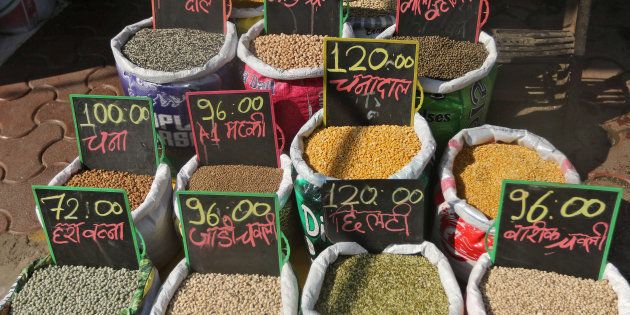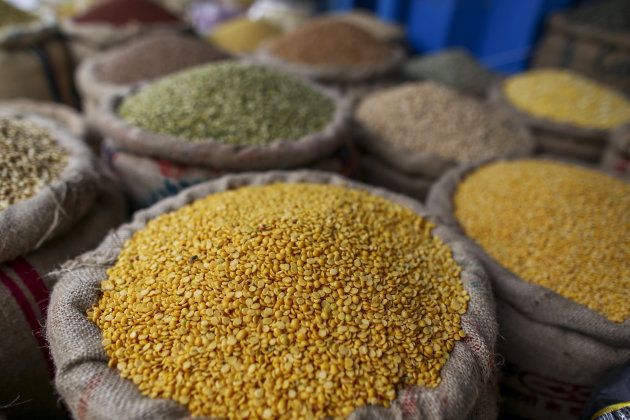
In October 2015, a little over a year after Narendra Modi became prime minister, the price of pulses suddenly saw a sharp increase. It was, as it often is, election season. Narendra Modi had staked his own persona in the high-pitched battle for Bihar. Lalu Yadav's supporters came up with a biting slogan: Arhar Modi, a pun on Har Har Modi, Ghar Ghar Modi – the slogan for the PM's Lok Sabha campaign in Varanasi.
Arhar dal, also known as Tur or Split Pigeon Pea, is an Indian staple. Since Arhar Modi, the government has imported pulses in such large quantity that it has caused a glut in the market. There's mayhem among farmers, they are unable to sell pulses even at the minimum support price, which they complain is already a lot less than minimum should be.
It was only in May 2017 the government finally relented and decreased its Tur import quota, increasing the import duty on it. In financial year 2016-17, the total import of pulses increased by 20 percent.
By not raising MSP the Modi government is exacerbating rural distress, but it doesn't seem to mind: controlling inflation is the top priority.
Agriculture expert Devender Sharma has wondered why the government has been punishing Indian farmers — increasing pulses at a high price while refusing to increase the MSP — making prices crash and farming unviable. While the government has been causing a glut of pulses so that sudden lack of supply doesn't result in inflation, it doesn't want to increase the money in the farmers' pockets as their consumption will boost rural demand and hence inflation. (The government blamed back-to-back droughts as the need to increase imports.)
By not raising MSP the Modi government is exacerbating rural distress, but it doesn't seem to mind: controlling inflation is the top priority.
The case of Tur Dal is just a snapshot of Modi's one-point economic policy: keeping inflation low at any cost. And the Bihar election was no turning point; inflation had been a top priority for Modi from day one.
In March 2015, the Modi government and the Raghuram Rajan-led Reserve Bank of India agreed to make a historic change in India's monetary policy, making inflation-targeting the centerpiece of it. They agreed to amend the RBI Act and create a monetary policy committee that would give the centre a greater say than earlier.
Just before Rajan stepped down as RBI chief, the government agreed with him on setting an inflation target of 4%, with a minimum of 2% and maximum of 6%. Rajan was criticised by many for sacrificing growth at the altar of inflation targeting, because this required him to not lower interest rates beyond a point.

But after Rajan left, the RBI and the government have continued with the policy. Modi even hailed inflation targeting in his 2016 independence day speech.
The BJP's in-house loose canon, Subramanian Swamy, had called Raghuram Rajan "mentally not fully Indian" for choosing inflation targeting over rate cuts, alleging that he was wrecking the Indian economy. Swamy had demanded Rajan's sacking. But the Modi government's backing of inflation targeting has only proved that it needed that move more than Rajan.
It is nearly impossible for any central government to be re-elected if there's high inflation. People react instantly and angrily to mehngai, price rise, and never blame state governments or global factors for it. In a emerging economy like India, keeping inflation low is often difficult. High growth needs high economic activity resulting in high inflation. Between high growth and losing elections, the Modi government has made a clear choice.
Between high growth and losing elections, the Modi government has made a clear choice.
Given the Reserve Bank of India has lost its claims to being an autonomous institution since demonetisation, it's clear who is calling the shots on the monetary policy.
Demonetisation, by stifling economic activity, resulted in lowering inflation even further. That may well have been one of the considerations in going ahead with demonetisation: an unintended side benefit.
One great risk to inflation is the Goods and Services Tax. Across the world, the introduction of GST, with all the preparation and precautions, results in raising inflation substantially for a year or two. (Thereafter, it helps bring keep inflation in check.)
This is why the government was in a crying hurry to introduce GST in the middle of the financial year. It didn't want GST to happen too close to 2019. Despite keeping more than half the items of the Consumer Price Index out of GST, it is already contributing to raising inflation again. But thanks to the dip caused by demonetisation, GST-caused inflation won't pinch as much.
Defending his government's management of the economy last week, the first data point the prime minister showed was a comparison of inflation in his three years and the last three years of UPA-2.
While UPA-2 lost the political narrative to one alleged scam after another, surveys showed people were most angry about inflation. Thanks to generous increases in MSPs for farmers, high crude prices and other factors, the UPA years were marked by high inflation.
The Modi government has been lucky with inflation thanks to record low oil prices, but those are rising again. There have been other factors, such as the increase in wages of government employees. The economic slowdown, caused partially by the disastrous decision of demonetisation, is helping Modi succeed in his one-point economic agenda: low inflation.
The government could increase MSP for farmers, and provide a rural stimulus, just before the 2019 elections, possibly in the forthcoming budget. That way, it would hope to appease farmers, while making sure inflation impact is not felt before the summer of 2019.